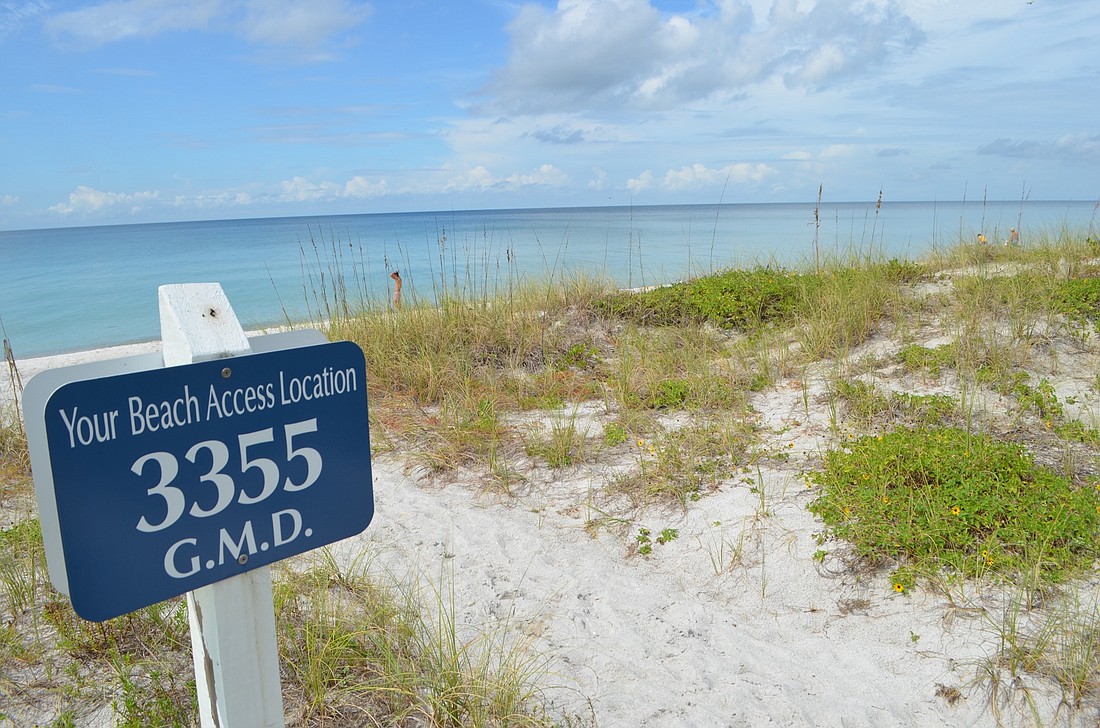- April 18, 2024
-
-
Loading

Loading

When commissioners gather next week to discuss the town’s next comprehensive beach management plan, they’ll be presented with dollar figures, cost estimates and potential millage rates.
And they might also be presented with something a little more tangible: samples of offshore sand, courtesy of Charlie Mopps, a scuba-certified beach project manager for Longboat Key.
As the town draws closer to a December deadline to produce March 2020 ballot language for borrowing to pay for the next plan's renourishment and monitoring, leaders are hearing a lot about the town’s erosional hotspots and the sources of sand to alleviate the problems.
Since 1993, the town has placed more than 7.5 million cubic yards of sand on beaches from one end of the island to the other, always aiming for a design width of 120 feet. Its first comprehensive beach plan was launched in 1995 and updated in 1999. A second update took place in 2008, and a multi-phase renourishment took place in 2016. The current plan is running out at the end of the 2020 fiscal year, which is why town leaders are moving now to have a new plan and its financing -- and the property tax rates to pay it back -- ready to go.
The March ballot is preferred to allow for smooth integration into next summer's budget process. A delay to next summer's countywide primary date in August or even to November 2020's general election could set the plan's borrowing and implementation back a year.
More than just renourishment, comprehensive beach plans identify current and future needs and monitor beach data, critical to maintaining eligibility for reimbursement from federal authorities after a storm. The plan under consideration would cost around $42 million, but commissioners and town staffers are trying to figure out how much to ask town residents to authorize in borrowing.
Generally speaking, the higher-quality the sand, the more expensive it becomes, ranging from about $17-$22 per cubic yard from nearby dredge sources, such as Longboat Pass or New Pass, to about $60 per cubic yard for the finest, truck-hauled sand from inland mines.
Sand dredged from Passage Key, a borrow site offshore Anna Maria Island and Egmont Key, runs about $50 a cubic yard. And when the town’s sand shopping list stands between 800,000 and 900,000 cubic yards for the next round of work – enough to fill 10,000 typical back yard swimming pools – sources and final outcomes matter.
Even if the town decided it wanted to pay the millions-more premium for trucked-in sand, that could lead to more than 30,000 trucks coming and going to accomplish the goal. Mayor George Spoll at a recent meeting balked at such an idea as potentially damaging to local roads and an example of short-term thinking, instead wondering why a more permanent and less intrusive delivery method for prime sand hasn't yet been developed.
"Someone is going to have to pay for that,'' he said of road damage.
One of the options presented by the town relies on 512,000 cubic yards of truck-hauled sand and a cost millions higher than plans that use offshore dredges.
Lower-priced Passage Key sand is generally darker, coarser and a bit harder to visualize than the white sand from places such as Immokalee mines. Sand for the emergency work on the north end of the island in 2018 was hauled to the site by truck.
At issue is the final product, something Longboat Key residents and leaders don't take for granted.
“If I asked you to give me some truck-haul sand, you could go get it tomorrow and I would know what it looks like,’’ Commissioner Mike Haycock said. “If I asked you to go get me some sand from Passage Key, so I know what that looks like, I don’t know if you could do that. I mean hold it in my hand.’’
Mopps, the project manager for the town’s beach plan, is a certified scuba diver and offered to bring back sand to Town Hall from Passage Key, for town leaders to see.
The town's favored plan is built around Passage Key sand and sand pulled from Longboat Pass and New Pass for the north and south ends, respectively. At a sand cost of $25 million, that work would likely last around eight years in the north and central zones, 6-7 years in the south and less around the unique aspects of Gulfside Drive.
Another 100,000 cubic yards of sand, and another $5 million, would extend the longevity of the work to about eight years everywhere but the erosion-prone area near Gulfside Drive, where a seawall juts into the surf behind one home.
As Public Works Director Isaac Brownman said, costs and shelf-life of the sand are all estimates and can change. He said Finance Director Sue Smith stayed conservative with the costs of the sand to head off the possibility of not borrowing enough to accomplish overall goals.
"As we move forward with each of these projects and we can realize some cost savings and realize some better reimbursement rates (from state-government sources), she stayed conservative,'' he said. "So, as we march through the years, those savings might realize themselves, we just can't tell you what those would be.''